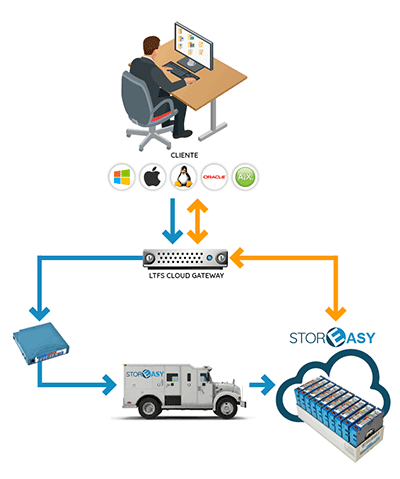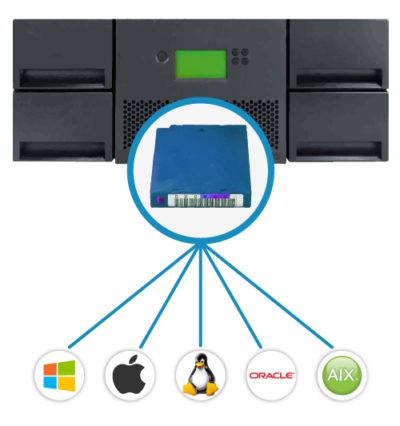The next generation Hybrid Cloud Storage platform for data protection
The service relies on StorEasy’s innovative LTFS Cloud Gateway technology to simultaneously make two identical copies of data generated by users and applications, one on a secure Linear Tape File System (LTFS) local archive and the other in the cloud. The hybrid architecture uses different storage tiers to ensure high performance and security and extremely low operating costs compared with traditional disk-based storage systems. The architecture is made up of flash memory for the front-end and a compact LTO library as back-end. This secure and highly resilient environment requires no separate data protection backup procedures.
The StorEasy LTFS Cloud Gateway Solution offers:
Multiple copies of the data in the cloud and on a secure LTFS as NAS local archive
Massive writing and reading of data, in the order of TBs, rapidly to local archive and subsequently (via programmable policies) to the cloud
Physical migration of media/data to the StorEasy cloud and put online quickly after reception at our data center (within 24 hours)
3-2-1 data protection (three copies of the data, two on different storage technologies, one in the cloud)
The StorEasy LTFS Cloud Gateway Solution guarantees access to previously archived data even if a cloud connection is unavailable
The LTFS Cloud Gateway solution makes two identical and simultaneous copies of data produced by users and applications, one on a local archive and the other in the StorEasy cloud.
When an application or a user requests data that has been migrated and archived to the StorEasy cloud, it is immediately restored to its original location completely automatically and transparently.
Should a connection be unavailable, or, if rapid high capacity reading / writing is essential, users can directly access the local LTFS as NAS archive integrated inside the Gateway.
Cost/Benefit Analysis of a Tape as NAS solution compared with traditional disk-based archiving
The StorEasy LTFS Cloud Gateway solution provides a secure, reliable and economic technology that can store data for a period of up to years or decades, an elastic memory that can be used to store unlimited quantities of data at a fraction of the cost, whether in terms of capacity (TB/€) or operating costs (power, cooling, maintenance, management and duration), of any storage technology available on the market today.
Capacity/Cost
TCO
Conservation
Error Rate
Costs
We guarantee the migration of data in LTFS format and its availability online within 24 hours of reception at our data centers, without any limit for the capacity!
The LTFS Cloud Gateway solution also allows clients to copy/migrate their data very quickly from on-premise infrastructure to the StorEasy cloud through LTO/LTFS media. We guarantee its availability online within 24 hours of reception at our data centers. From an operating standpoint, data moved to the cloud is accessible and shareable just like a traditional Windows folder or Linux mount point directory, depending on the client’s needs or operating system.
This service offers numerous benefits including:
LTO technology – unparalleled reliability, capacity and performance
Data is written to the StorEasy LTFS Cloud Gateway immediately with no difference in performance to enterprise class NAS systems. Whether single drive or tape library, LTO technology in fact plays an important role in medium- and long-term data conservation. Data archived on LTO tapes for periods of over 30 years support a million recordings and 20,000 writing cycles per tape, and an MTBF (mean time between failures) of 250,000 hours at a 100% duty cycle.
A single LTO-8 tape offers 12TB of native capacity, 30TB compressed. This means a native data transfer rate of 360MB/second, through to 900MB/second compressed, while a 15,000 rpm SAS hard disk offers a write transfer rate of only 148MB/second.
Extraordinary longevity
Besides the undoubted economic benefits of this technology for medium- and long-term archiving, a tape archive offers extraordinary longevity; it is possible to archive data securely for years or even decades. We guarantee the duration of the data for a period of 30 years if conserved in a controlled temperature (20°C) and humidity environment.
In addition to the manufacturers’ guarantee of the integrity of data archived, the StorEasy Cloud Gateway offers further levels of control against damage, wear and tear or corruption of the magnetic support. Data integrity is controlled by scheduled scans/validation of each file memorized on the LTO/LTFS media.
Linear Tape File System (LTFS) – ISO/IEC 20919:2016 Standard
The LTFS format used to record the LTO media is ISO/IEC 20919:2016 compliant, a standard that guarantees the interchangeability of media among various operating systems (Windows, Linux, Unix and MAC). The solution handles the importation of LTFS file systems created outside the main archive, for example, by a remote site that has adopted the same standard.
LTO/LTFS media can be imported/exported for:
Massive transfer of data between different remote sites. Data recorded on LTO/LTFS media can be migrated and copied to the LTFS Cloud Gateway and then made available for reuse
Conservation in the LTFS Cloud Gateway as an independent element of the archive itself. In the same way, LTFS media created inside the LTFS Cloud Gateway environment can be exported to other sites
The most significant feature of the LTFS ISO/IEC 20919:2016 standard is the ability to move recorded media between different operating systems, applications and platforms, allowing us to use the tape to all intents and purposes like a traditional disk or USB flash drive.
Transparency is so complete that you can drag and drop files from folders in the archive to tape and vice versa, using standard commands.
Using simple policies that include a range of file properties, such as creation date, last access, file owner, size, format and last edit, you can migrate and archive files from on-premise storage infrastructure to the cloud and at the same time to the local LTFS Cloud Gateway archive.
The migration and archiving process is completely transparent to applications, the network and to users. Even though the files (metadata) continue to appear in the original directory from which they were removed, their content is simultaneously archived and protected in the cloud and the local gateway.
The files migrated and archived in the cloud reappear in real time in their original position when requested by users or applications. If users need to read or archive a large quantity of data rapidly, they can access it directly in the local archive.
Archival data protection that goes beyond market standards
The LTFS Cloud Gateway protects the data through multiple copies in the local archive and in the StorEasy cloud to be used in the event of a disaster. If a copy of the data in the tape library becomes illegible for whatever reason, the second or third copy of the damaged file is automatically retrieved and used.
Multiple Copies
Incremental Copies
Multiple Incremental Copies
Data conservation policies
Once the retention period has expired, the data and associated metadata can be eliminated or switched to read/write. Based on the client’s archiving criteria, a range of conservation periods can be adopted to create volumes/folders associated with each set of cartridges. For example, a retention period of 2 years can be set for one set of cartridges, while another has a retention period of 10 years. The same (or another) retention period can be specified for the data archived in the cloud.



